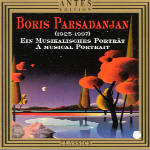Armenian composer Boris Parsadanjan (1925-97) got his musical education at Moscow’s famous Gnessin School where everyone (at the time) was under the influence of Shostakovich. Though Parsadanjan went on to Tallinn to study composition with Heino Eller, he still ended up composing in Shostakovich’s shadow, as evidenced by his String Quartet of 1974, which carries many reminders–including shrill violins and deep-register cello lines–of the great master’s style. In fact, many listeners will find it difficult to distinguish this work from any one of Shostakovich’s early string quartets. This pervasive influence also holds true for Parsadanjan’s Sonata for Violin and Cello (1975) which, although excellently performed here, suffers from a strange balance problem: the violin seems as if it’s at least 10 feet away from the microphone. (This work may have been recorded on an open stage rather than a closed studio.)
The Concerto for Flute and Orchestra brings Shostakovich to mind again–this time it’s the merry opening and closing movements of the Ninth Symphony. Flutist Samuel Saulus is superb, and for this work the overall sonics are very good. Parsadanjan’s Seventh Symphony offers greater originality in its use of atonal techniques, but it’s not compelling enough or original enough to place it among the strongest or sturdiest 20th century works in the symphonic repertoire. In fact, unless you’re just interested in hearing music by another Shostakovich imitator, albeit a rather skillful one, there’s not much here to compel your attention.
































